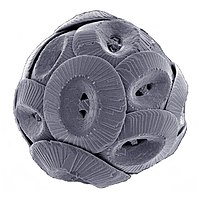
Photo from wikipedia
Abstract There are various mechanisms through which bacteria precipitate calcium carbonate, out of which a few have been recognised for application in concrete for crack healing. This paper first presents… Click to show full abstract
Abstract There are various mechanisms through which bacteria precipitate calcium carbonate, out of which a few have been recognised for application in concrete for crack healing. This paper first presents a review of work carried out on microbial concrete from the viewpoint of microbial induced carbonate precipitation (MICP) mechanisms. The mechanisms so far applied to concrete have limitations, especially with regard to their applicability to structures exposed to different environmental conditions. The paper considers the issue and presents a consolidated study of all the known MICP mechanisms, highlighting their associated advantages and disadvantages, for use in concrete structures. Based on this, guidelines are provided for the selection of the most suitable bacteria for natural crack remediation of a concrete structure exposed to a particular environment. Apart from crack healing, the study also throws light on some significant additional benefits of certain MICP mechanisms for use in concrete.
Journal Title: Construction and Building Materials
Year Published: 2019
Link to full text (if available)
Share on Social Media: Sign Up to like & get
recommendations!